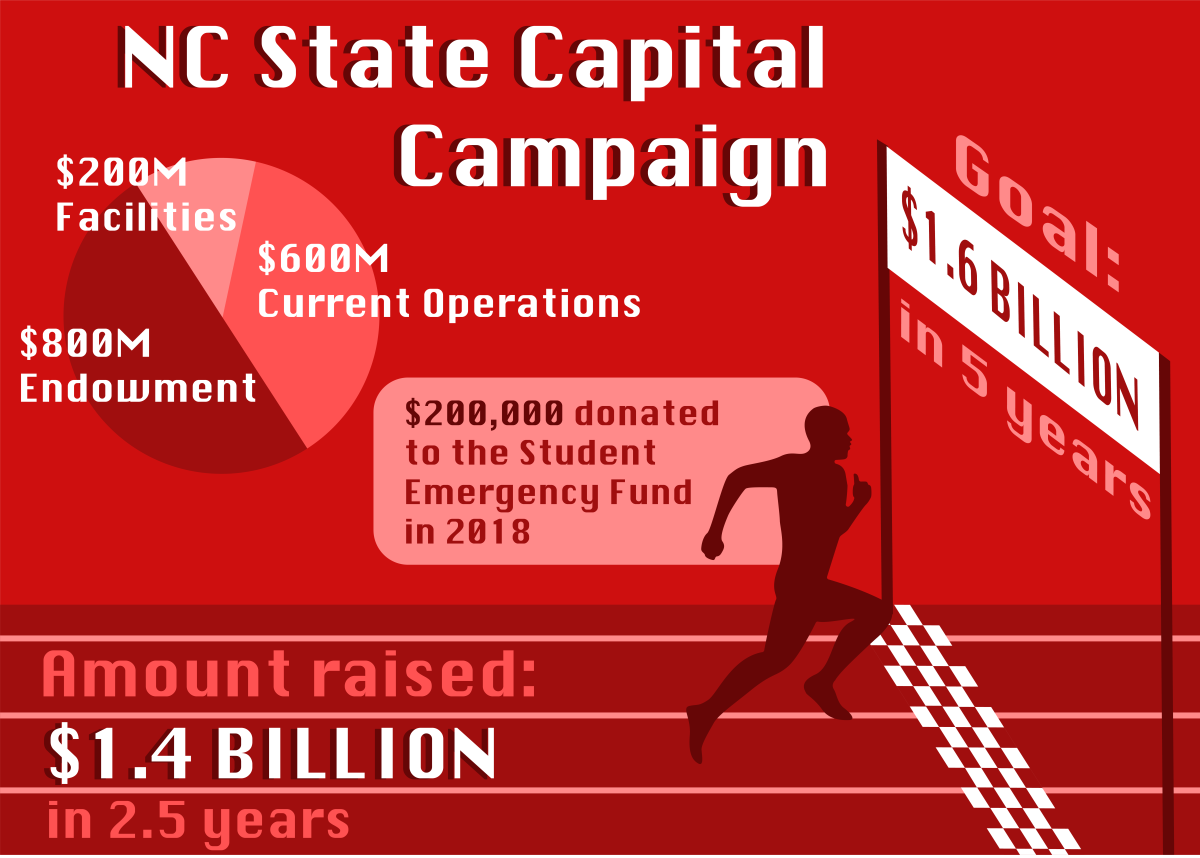NC State’s prime fundraising initiative, the Capital Campaign, has nearly reached its goal of $1.6 billion, in about half the expected 5-year fundraising period.
The campaign began in October 2016 and is expected to end by the end of 2021. The money raised through the initiative is going towards funding for scholarships, professorships, new buildings, new programs and general upkeep of the university, among other things.
Current donations total over $1.4 billion, meaning that what was meant to take five years looks to be completed in about half that time.
Jim Broschart, associate vice chancellor for University Development, discussed his excitement about the campaign’s success, saying that it reflects highly on everyone involved.
“It’s a reflection of the good work that’s going in this university right now,” Broschart said. “I think alumni and donors are noticing the great leadership of the chancellor, they’re noticing the momentum at the university right now.”
Brian Sischo, vice chancellor for University Advancement, said that one of the most important donation efforts this year was to NC State’s Student Emergency Fund. Sischo said that over $200,000 has been raised specifically for that fund.
“In the wake of Hurricane Florence, there were a number of students down east in North Carolina that were significantly affected by the hurricane, many of them needing financial assistance, whether it be housing or food,” Sischo said.
In the campaign, scholarships are also a priority, and according to Sischo, a lot of progress has been made on that end.
“We have donors that, in the time of this campaign, have created 400 scholarship funds,” Sischo said.
Sischo and Broschart both said that one of NC State’s top priorities with fundraising was allowing donors to give to a specific cause they want.
“Ultimately, we’re most successful if we can connect donors with the things they’re most passionate about,” Sischo said. “Our job is to find out what they really are interested in and work with them to support the things they are interested in.”
Gifts tend to vary quite a lot on a donor-to-donor basis, Broschart said.
“We get to know the donor, we get to know what they’re interested in,” Broschart said. “Most of the time, they’ll talk about what they’re interested in. Endowments can come in all shapes and sizes and support all kinds of different things.”
Recently, news of a major donation to the university was made public: that from the Wilson family to the Wilson College of Textiles. According to Sischo, this is a prime example of a donor connected to a very specific cause.
“That’s an example of a family that’s not only committed to what NC State is doing in the field of textiles, but it was important for them that the textile industry is in fact resurging at this moment in time,” Sischo said.
Approximately three-quarters of donations come from individuals, Broschart said.
“Most of what we raise comes from individuals. A lot of them are alumni – in fact, most of them are alumni, but also corporations and foundations give to campaigns, too, and care about the things that happen in higher education,” Broschart said. “In higher education, that’s where a lot of the problems of the world get addressed and get solved.”
Sischo explained that donations from corporations are seen as investments into the products of the university, the most obvious being research and graduates.
“[Corporate donors] look at this from a standpoint of investing in the institution, which ultimately supports them both directly and indirectly down the road,” Sischo said. “That relationship is one that’s often built on a mutually beneficial partnership where the individuals may shift over time.”
The success of this campaign ultimately speaks to the nature of donors, Sischo said.
“Our constituents have really dug deep in order to support the initiatives embodied in the campaign,” Sischo said. “I think it speaks to the passion and spirit that our alumni and friends have for this great university.”








